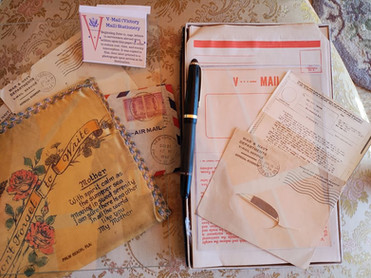Christmas Greetings - #2
- Cat T. Gardiner

- Dec 5, 2019
- 2 min read
Updated: Oct 29, 2024
V-Mail Artwork
Transporting letters overseas in wartime was an expensive - weighty - endeavor, particularly at Christmastime. Just imagine the sheer number and tonnage of letters (not to mention care packages) sent to the Armed Forces. Here's an example: 150,000 one-page letters took up 36 mail bags and weighed over 2,500 pounds! In my collecting of wartime letters, I have only come across letters of three or more pages. Sometimes as much as eight!
In seeking a remedy to cut costs, the U.S Post Office, the War, and the Navy Departments looked to Great Britain and a program they had once used. V-Mail, short for Victory Mail, was introduced in 1943. An 8 1/2 x 11 all-in-one envelope and writing space that folded onto itself. It was a secure method of correspondence. The original letter was processed through the military postal service, opened, censored then Micro Photographed. The original letter was destroyed and the microfilm was transported overseas and developed at V-Mail stations. Eastman Kodak was responsible for the photography operations . Placed in an envelope it was then delivered to the service member. The printed copy was a 1/4 the size of the original letter. Thus, this reduced the same amount (150,000) above reference to only one mailbag of microfilm, weighing only 45 lbs. So, you can imagine how the War Dept. pushed the propaganda to get Americans on board. Why, V-Mail even received a mention in Basil Rathbone's "Mr. Sherlock Goes to Washington!"
As cost effective as the program was, it was largely unpopular with Americans as there was a space limitation and the inability to include anything in the envelope. Items such as snapshots bridged separating miles and helped our fighting forces battle homesickness, but they could not be included in a V-Mail. Goodness, even imprints of affection were problematic in the processing:
" One particular jam came from lipstick! Sweethearts puckering up to send kisses from home left colorful lipstick residue that gummed up the microfilm machinery and was dubbed the "Scarlet Scourge." The pleas to the public to leave off signs of love and affection reminded many letter writers of V-Mail’s impersonal elements. Not only did the V-Mail process not allow kisses, but the facsimiles couldn’t carry the scent of a familiar perfume either. " - Smithsonian National Postal Museum
However, artistic servicemen used the 'writing' space to draw their greeting cards during the holidays, sending their own uniquely special 'Merry Christmas', giving their family on the home front a glimpse of life 'on the front'. According to the Postal Museum, there were even pre-printed contents available in a variety of cartoons and holiday messages. Units with talented artists and access to printing facilities produced V-Mail sheets with greetings.








Comments